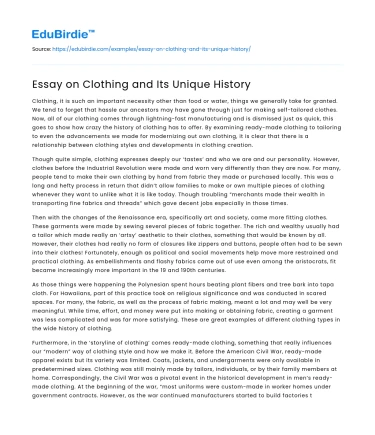Clothing, it is such an important necessity other than food or water, things we generally take for granted. We tend to forget that hassle our ancestors may have gone through just for making self-tailored clothes. Now, all of our clothing comes through lightning-fast manufacturing and is dismissed just as quick, this goes to show how crazy the history of clothing has to offer. By examining ready-made clothing to tailoring to even the advancements we made for modernizing out own clothing, it is clear that there is a relationship between clothing styles and developments in clothing creation.
Though quite simple, clothing expresses deeply our ‘tastes’ and who we are and our personality. However, clothes before the Industrial Revolution were made and worn very differently than they are now. For many, people tend to make their own clothing by hand from fabric they made or purchased locally. This was a long and hefty process in return that didn’t allow families to make or own multiple pieces of clothing whenever they want to unlike what it is like today. Though troubling “merchants made their wealth in transporting fine fabrics and threads” which gave decent jobs especially in those times.
Save your time!
We can take care of your essay
- Proper editing and formatting
- Free revision, title page, and bibliography
- Flexible prices and money-back guarantee
Then with the changes of the Renaissance era, specifically art and society, came more fitting clothes. These garments were made by sewing several pieces of fabric together. The rich and wealthy usually had a tailor which made really an ‘artsy’ aesthetic to their clothes, something that would be known by all. However, their clothes had really no form of closures like zippers and buttons, people often had to be sewn into their clothes! Fortunately, enough as political and social movements help move more restrained and practical clothing. As embellishments and flashy fabrics came out of use even among the aristocrats, fit became increasingly more important in the 19 and 190th centuries.
As those things were happening the Polynesian spent hours beating plant fibers and tree bark into tapa cloth. For Hawaiians, part of this practice took on religious significance and was conducted in scared spaces. For many, the fabric, as well as the process of fabric making, meant a lot and may well be very meaningful. While time, effort, and money were put into making or obtaining fabric, creating a garment was less complicated and was far more satisfying. These are great examples of different clothing types in the wide history of clothing.
Furthermore, in the ‘storyline of clothing’ comes ready-made clothing, something that really influences our “modern” way of clothing style and how we make it. Before the American Civil War, ready-made apparel exists but its variety was limited. Coats, jackets, and undergarments were only available in predetermined sizes. Clothing was still mainly made by tailors, individuals, or by their family members at home. Correspondingly, the Civil War was a pivotal event in the historical development in men’s ready-made clothing. At the beginning of the war, “most uniforms were custom-made in worker homes under government contracts. However, as the war continued manufacturers started to build factories that could quickly and efficiently meet the growing demands of the military. With rapid succession, the mass-producing uniform was a hit however measurements were still needed to gain a regularity between sizes. They started taking measurements of soldiers and it revealed that certain sets of measurements tend to recur with predictable regularity.
After the war, these measurements were implemented to create the first commercial sizing scales for men. Surprisingly these ratios persist in names of fits and cuts in men’s suits, shirts, and also denim jeans. The mass production of women’s clothing, however, developed slowly than men’s. But as time went on and a number of factors came into play to contribute to the success of the women’s ready-made apparel industry. The purchase of these mass-produced clothing was sometimes seen as a loss of individuality. However, American women began to accept these ready-made clothes as convenient and affordable.
However, these new ready-made clothing was often fitted poorly. A tailor would still have to adjust the measurements when making a men’s suit or a lady’s dress. What matters worse manufacturers created their own unique and sometimes arbitrary sizing system. This system resulted in additional expenses for the consumer to alter their garments. It wasn’t until 1973 that the USDA helped to create a standardized sizing system the entire industry could follow.
As time went on, as well countless fads and fashion trends came along, we come along to the advancements in modern clothing. During the late 20th and early 21st centuries, computer technology has advanced exponentially. This allows today’s fashion designers ‘unprecedented freedom’ to express their creativity. Instead of creating sketches by hand taking hours upon hours they now use computer-aided design software (CAD) that grants these designers to create something that could only be dreamt about.
The impact of CAD software on everyday clothing is becoming more and more prevalent as the software is linked to 3D printing technology. 3D technology could well be the future of clothing Designers has since been experimenting with 3D printed apparel, and this could revolutionize the experience of buying clothes for the average consumer. Though it may be a while before anyone can print out their own clothes, this ability to create customized clothing is becoming more and more of a reality as technology evolves.
As we fall into an era so filled with technology, it’s crazy to think what’s next. What’s next for the future of apparel, could it be that we will one day wear our own one-of-a-kind, perfectly tailored clothes? But I do know is that we’ve come a long way and the evidence is here. This unique history is an intermingled relationship of all styles, concepts, and truly remarkable advancements.






 Stuck on your essay?
Stuck on your essay?

